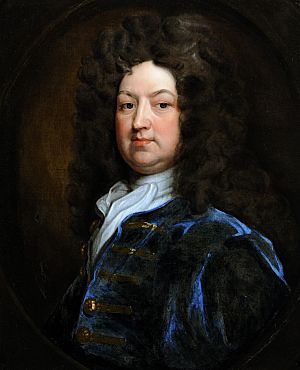Charles Churchill (British Army officer, born 1656) facts for kids
Quick facts for kids
Charles Churchill
|
|
|---|---|

A painting of Charles Churchill by the circle of Godfrey Kneller
|
|
| Born | 2 February 1656 |
| Died | 29 December 1714 (aged 58) |
| Allegiance | |
| Service/ |
English Army |
| Rank | General |
| Commands held | 3rd Regiment of Foot Coldstream Guards Centre / Allied Army |
| Battles/wars | Monmouth Rebellion |
| Relations | Winston Churchill (Father) Elizabeth Drake (Mother) |
| Other work | Lieutenant of the Tower of London Governor of Guernsey Member of Parliament |
General Charles Churchill (born February 2, 1656 – died December 29, 1714) was an important British Army officer. He also served as an English politician. He was a Member of Parliament (MP) from 1701 to 1710. Charles was the younger brother of the famous Duke of Marlborough. Their careers were often linked. Charles was a close advisor to his brother. He was a member of the Tory political group.
| Top - 0-9 A B C D E F G H I J K L M N O P Q R S T U V W X Y Z |
Life as a Soldier and Politician
Charles Churchill was the son of Winston Churchill and Elizabeth Drake. From 1672 to 1708, he worked in the household of Prince George of Denmark. In 1702, he became the Lieutenant of the Tower of London. This was an important job in charge of the famous Tower.
Joining the Army
Charles Churchill joined the English Army in 1674. He started as an ensign in the 3rd Regiment of Foot. Later, he became the leader, or colonel, of this unit. He fought in many important wars and battles.
Key Battles and Promotions
Churchill fought in the Monmouth Rebellion at the Battle of Sedgemoor. He also served under his brother, the Duke of Marlborough. Together, they captured Cork in Ireland in 1690. This was during a time when some Irish forces supported King James II.
After Ireland, he fought in Europe during the Nine Years' War. He was part of the battles of Steenkerque and Landen. Charles Churchill was promoted to brigadier-general in 1690. He became a major-general in 1694.
Serving in Parliament
In 1701, Charles Churchill became a Member of Parliament for Weymouth and Melcombe Regis. He was re-elected several times. In 1702, he became a lieutenant-general. He also took command of the famous Coldstream Regiment of Foot Guards.
Leading in the War of the Spanish Succession
Churchill played a big role in the War of the Spanish Succession. At the Battle of Blenheim in 1704, he served under his brother. He commanded the center part of the allied army. During the march to the Danube River, he was in charge of the artillery (cannons) and infantry (foot soldiers).
At the Battle of Ramillies, he again served under his brother. He ordered four brigades of foot soldiers to attack a village. In 1706, he stopped being the Lieutenant of the Tower. He then became the Governor of Guernsey until 1711. In 1707, he was made a full general. He continued to serve as an MP for Weymouth until 1710.
Family Life
Charles Churchill married Mary Gould in 1702. She later married another important person, the Earl of Abingdon.
Charles Churchill had a son named Charles Churchill, who also became a lieutenant-general. His grandson, also named Charles Churchill, became an MP. This grandson married Lady Maria Walpole. She was the daughter of the famous politician Robert Walpole.
Charles Churchill had a sister named Arabella. She was a royal mistress to King James II of Great Britain. His brother, George, became an admiral in the navy.

